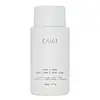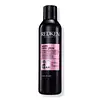What's inside
What's inside
 Key Ingredients
Key Ingredients

 Benefits
Benefits

 Concerns
Concerns

 Ingredients Side-by-side
Ingredients Side-by-side

Water
Skin ConditioningDimethicone
EmollientPhenyl Trimethicone
Skin ConditioningC11-13 Isoparaffin
SolventIsohexadecane
EmollientDimethiconol
EmollientPropanediol
SolventGlycerin
HumectantAcrylamidopropyltrimonium Chloride
C13-15 Alkane
SolventParfum
MaskingPanthenol
Skin ConditioningOryza Sativa Bran Extract
Skin ConditioningHydrolyzed Hyaluronic Acid
HumectantSodium Hyaluronate
HumectantOryza Sativa Seed Water
AntimicrobialRosmarinus Officinalis Leaf Extract
AntimicrobialHelianthus Annuus Extract
EmollientHydrogenated Castor Oil/Sebacic Acid Copolymer
EmollientSodium Stearoyl Glutamate
CleansingCaprylyl Glycol
EmollientCetearyl Alcohol
EmollientCoceth-7
EmulsifyingTocopherol
AntioxidantGlyceryl Stearate Se
EmulsifyingSaccharomyces Ferment
Skin ConditioningLactobacillus Ferment
Skin ConditioningLactic Acid
BufferingCellulose Gum
Emulsion StabilisingMicrocrystalline Cellulose
AbsorbentGuar Hydroxypropyltrimonium Chloride
Skin ConditioningCitric Acid
BufferingSorbitan Isostearate
EmulsifyingSodium Hydroxide
BufferingPhenoxyethanol
PreservativeChlorphenesin
AntimicrobialLimonene
PerfumingAlpha-Isomethyl Ionone
PerfumingGeraniol
PerfumingHydroxycitronellal
PerfumingWater, Dimethicone, Phenyl Trimethicone, C11-13 Isoparaffin, Isohexadecane, Dimethiconol, Propanediol, Glycerin, Acrylamidopropyltrimonium Chloride, C13-15 Alkane, Parfum, Panthenol, Oryza Sativa Bran Extract, Hydrolyzed Hyaluronic Acid, Sodium Hyaluronate, Oryza Sativa Seed Water, Rosmarinus Officinalis Leaf Extract, Helianthus Annuus Extract, Hydrogenated Castor Oil/Sebacic Acid Copolymer, Sodium Stearoyl Glutamate, Caprylyl Glycol, Cetearyl Alcohol, Coceth-7, Tocopherol, Glyceryl Stearate Se, Saccharomyces Ferment, Lactobacillus Ferment, Lactic Acid, Cellulose Gum, Microcrystalline Cellulose, Guar Hydroxypropyltrimonium Chloride, Citric Acid, Sorbitan Isostearate, Sodium Hydroxide, Phenoxyethanol, Chlorphenesin, Limonene, Alpha-Isomethyl Ionone, Geraniol, Hydroxycitronellal
Water
Skin ConditioningPropylene Glycol
HumectantHydrogen Peroxide
AntimicrobialOleyl Alcohol
EmollientPPG-2 Butyl Ether
Skin ConditioningLaureth-2
CleansingSodium C14-16 Olefin Sulfonate
CleansingPEG/PPG-4/12 Dimethicone
EmulsifyingCocamide Mipa
EmulsifyingAmodimethicone
Glycerin
HumectantPrunus Armeniaca Kernel Oil
MaskingParfum
MaskingDimethicone
EmollientCitric Acid
BufferingCarbomer
Emulsion StabilisingEthanolamine
BufferingLauryl Alcohol
EmollientPPG-5-Ceteth-10 Phosphate
EmulsifyingSodium Sulfite
PreservativeTaurine
BufferingCoco-Betaine
CleansingGuar Hydroxypropyltrimonium Chloride
Skin ConditioningMyristyl Alcohol
EmollientLimonene
PerfumingTrideceth-10
CleansingTrideceth-6
EmulsifyingTetrasodium Etidronate
Emulsion StabilisingSodium Chloride
MaskingTetrasodium Pyrophosphate
BufferingLinalool
PerfumingSodium Salicylate
PreservativeTetrasodium Glutamate Diacetate
Cetyl Alcohol
EmollientSodium Citrate
BufferingBenzyl Salicylate
PerfumingPEG-100 Stearate
Steareth-6
EmulsifyingCetrimonium Chloride
AntimicrobialBenzoic Acid
MaskingBenzyl Alcohol
PerfumingAlpha-Isomethyl Ionone
PerfumingTrideceth-3
EmulsifyingGlycine Soja Oil
EmollientArginine
MaskingSerine
MaskingTocopherol
AntioxidantGlutamic Acid
HumectantPhenoxyethanol
PreservativeTetrasodium EDTA
Acetic Acid
BufferingPentaerythrityl Tetra-Di-T-Butyl Hydroxyhydrocinnamate
AntioxidantWater, Propylene Glycol, Hydrogen Peroxide, Oleyl Alcohol, PPG-2 Butyl Ether, Laureth-2, Sodium C14-16 Olefin Sulfonate, PEG/PPG-4/12 Dimethicone, Cocamide Mipa, Amodimethicone, Glycerin, Prunus Armeniaca Kernel Oil, Parfum, Dimethicone, Citric Acid, Carbomer, Ethanolamine, Lauryl Alcohol, PPG-5-Ceteth-10 Phosphate, Sodium Sulfite, Taurine, Coco-Betaine, Guar Hydroxypropyltrimonium Chloride, Myristyl Alcohol, Limonene, Trideceth-10, Trideceth-6, Tetrasodium Etidronate, Sodium Chloride, Tetrasodium Pyrophosphate, Linalool, Sodium Salicylate, Tetrasodium Glutamate Diacetate, Cetyl Alcohol, Sodium Citrate, Benzyl Salicylate, PEG-100 Stearate, Steareth-6, Cetrimonium Chloride, Benzoic Acid, Benzyl Alcohol, Alpha-Isomethyl Ionone, Trideceth-3, Glycine Soja Oil, Arginine, Serine, Tocopherol, Glutamic Acid, Phenoxyethanol, Tetrasodium EDTA, Acetic Acid, Pentaerythrityl Tetra-Di-T-Butyl Hydroxyhydrocinnamate
 Reviews
Reviews

Ingredients Explained
These ingredients are found in both products.
Ingredients higher up in an ingredient list are typically present in a larger amount.
Alpha-Isomethyl Ionone is a fragrance. It can be synthetically created or naturally occurring.
The scent of Alpha-Isomethyl Ionone is described as "flowery" but can also be "woody".
Naturally occurring Alpha-Isomethyl Ionone may be found in Saccharomyces cerevisiae, or the yeast used to make wine and bread.
The term 'fragrance' is not regulated in many countries. In many cases, it is up to the brand to define this term. For instance, many brands choose to label themselves as "fragrance-free" because they are not using synthetic fragrances. However, their products may still contain ingredients such as essential oils that are considered a fragrance.
Learn more about Alpha-Isomethyl IononeCitric Acid is an alpha hydroxy acid (AHA) naturally found in citrus fruits like oranges, lemons, and limes.
Like other AHAs, citric acid can exfoliate skin by breaking down the bonds that hold dead skin cells together. This helps reveal smoother and brighter skin underneath.
However, this exfoliating effect only happens at high concentrations (20%) which can be hard to find in cosmetic products.
Due to this, citric acid is usually included in small amounts as a pH adjuster. This helps keep products slightly more acidic and compatible with skin's natural pH.
In skincare formulas, citric acid can:
While it can provide some skin benefits, research shows lactic acid and glycolic acid are generally more effective and less irritating exfoliants.
Most citric acid used in skincare today is made by fermenting sugars (usually from molasses). This synthetic version is identical to the natural citrus form but easier to stabilize and use in formulations.
Read more about some other popular AHA's here:
Learn more about Citric AcidDimethicone is a type of synthetic silicone created from natural materials such as quartz.
What it does:
Dimethicone comes in different viscosities:
Depending on the viscosity, dimethicone has different properties.
Ingredients lists don't always show which type is used, so we recommend reaching out to the brand if you have questions about the viscosity.
This ingredient is unlikely to cause irritation because it does not get absorbed into skin. However, people with silicone allergies should be careful about using this ingredient.
Note: Dimethicone may contribute to pilling. This is because it is not oil or water soluble, so pilling may occur when layered with products. When mixed with heavy oils in a formula, the outcome is also quite greasy.
Learn more about DimethiconeGlycerin is already naturally found in your skin. It helps moisturize and protect your skin.
A study from 2016 found glycerin to be more effective as a humectant than AHAs and hyaluronic acid.
As a humectant, it helps the skin stay hydrated by pulling moisture to your skin. The low molecular weight of glycerin allows it to pull moisture into the deeper layers of your skin.
Hydrated skin improves your skin barrier; Your skin barrier helps protect against irritants and bacteria.
Glycerin has also been found to have antimicrobial and antiviral properties. Due to these properties, glycerin is often used in wound and burn treatments.
In cosmetics, glycerin is usually derived from plants such as soybean or palm. However, it can also be sourced from animals, such as tallow or animal fat.
This ingredient is organic, colorless, odorless, and non-toxic.
Glycerin is the name for this ingredient in American English. British English uses Glycerol/Glycerine.
Learn more about GlycerinThis ingredient is derived from guar gum.
It is a conditioning ingredient, meaning it helps soften skin and hair.
Limonene is a fragrance that adds scent and taste to a formulation.
It's found in the peel oil of citrus fruits and other plants such as lavender and eucalyptus. The scent of limonene is generally described as "sweet citrus".
Limonene acts as an antioxidant, meaning it helps neutralize free radicals.
When exposed to air, oxidized limonene may sensitize the skin. Because of this, limonene is often avoided by people with sensitive skin.
The term 'fragrance' is not regulated in many countries. In many cases, it is up to the brand to define this term. For instance, many brands choose to label themselves as "fragrance-free" because they are not using synthetic fragrances. However, their products may still contain ingredients such as essential oils that are considered a fragrance.
Learn more about LimoneneParfum is a catch-all term for an ingredient or more that is used to give a scent to products.
Also called "fragrance", this ingredient can be a blend of hundreds of chemicals or plant oils. This means every product with "fragrance" or "parfum" in the ingredients list is a different mixture.
For instance, Habanolide is a proprietary trade name for a specific aroma chemical. When used as a fragrance ingredient in cosmetics, most aroma chemicals fall under the broad labeling category of “FRAGRANCE” or “PARFUM” according to EU and US regulations.
The term 'parfum' or 'fragrance' is not regulated in many countries. In many cases, it is up to the brand to define this term.
For instance, many brands choose to label themselves as "fragrance-free" because they are not using synthetic fragrances. However, their products may still contain ingredients such as essential oils that are considered a fragrance by INCI standards.
One example is Calendula flower extract. Calendula is an essential oil that still imparts a scent or 'fragrance'.
Depending on the blend, the ingredients in the mixture can cause allergies and sensitivities on the skin. Some ingredients that are known EU allergens include linalool and citronellol.
Parfum can also be used to mask or cover an unpleasant scent.
The bottom line is: not all fragrances/parfum/ingredients are created equally. If you are worried about fragrances, we recommend taking a closer look at an ingredient. And of course, we always recommend speaking with a professional.
Learn more about ParfumPhenoxyethanol is a preservative that has germicide, antimicrobial, and aromatic properties. Studies show that phenoxyethanol can prevent microbial growth. By itself, it has a scent that is similar to that of a rose.
It's often used in formulations along with Caprylyl Glycol to preserve the shelf life of products.
Tocopherol (also known as Vitamin E) is a common antioxidant used to help protect the skin from free-radicals and strengthen the skin barrier. It's also fat soluble - this means our skin is great at absorbing it.
Vitamin E also helps keep your natural skin lipids healthy. Your lipid skin barrier naturally consists of lipids, ceramides, and fatty acids. Vitamin E offers extra protection for your skin’s lipid barrier, keeping your skin healthy and nourished.
Another benefit is a bit of UV protection. Vitamin E helps reduce the damage caused by UVB rays. (It should not replace your sunscreen). Combining it with Vitamin C can decrease sunburned cells and hyperpigmentation after UV exposure.
You might have noticed Vitamin E + C often paired together. This is because it is great at stabilizing Vitamin C. Using the two together helps increase the effectiveness of both ingredients.
There are often claims that Vitamin E can reduce/prevent scarring, but these claims haven't been confirmed by scientific research.
Learn more about TocopherolWater. It's the most common cosmetic ingredient of all. You'll usually see it at the top of ingredient lists, meaning that it makes up the largest part of the product.
So why is it so popular? Water most often acts as a solvent - this means that it helps dissolve other ingredients into the formulation.
You'll also recognize water as that liquid we all need to stay alive. If you see this, drink a glass of water. Stay hydrated!
Learn more about Water